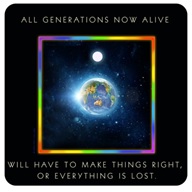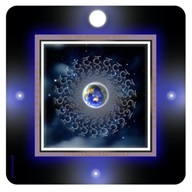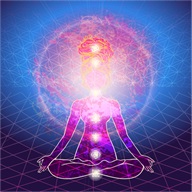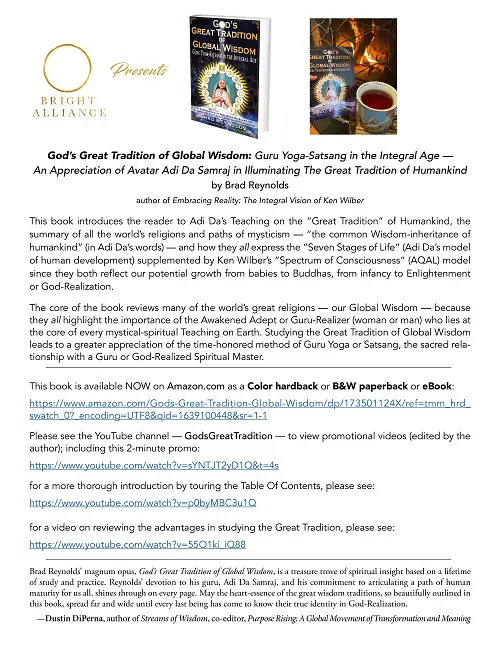|
TRANSLATE THIS ARTICLE
Integral World: Exploring Theories of Everything
An independent forum for a critical discussion of the integral philosophy of Ken Wilber
SEE MORE ESSAYS WRITTEN BY BRAD REYNOLDS
Part 1 | Part 2
Using the Great Tradition of Global Wisdom to Move Beyond Religious Provincialism & Scientific Materialism
God's Great Tradition of Global Wisdom
Chapter 1, Part 2
Brad Reynolds

—The World-Friend Adi Da Samraj, Not Two Is Peace
As our list of advantages to using the Great Tradition shows [see previous essay Chapter 1, Part 1], there are many benefits to be gained from studying the universal global wisdom we have all inherited from our wisest ancestors of past generations. It is the “Wisdom of the Ages” after all, one that has been bequeathed to us from our most beloved and evolved souls. Nevertheless, every generation must make anew its commitment to understand and access this storehouse of spiritual knowledge. Today with mass communication at an all-time high, such as with the Internet and smartphones, coupled with the incredible proliferation of sacred translations circulating the Earth more than at any other time of human history, we now have a far greater advantage (and responsibility) than any generation before us.
However, as the world shifted to the modern (and postmodern) mind it often dispensed with religious ideas and spiritual practices to embrace reductionistic materialism, the “religion” of science. Nonetheless, this book maintains we must preserve and embody this sacred knowledge so we may pass it on to our children, and to their children, far into the future. Consequently, for this knowledge to become true wisdom it must be grounded in actual practice (the “Practicing School”), not just scholarly study (or the “Talking School”). Access to this sacred wisdom is our most assured method for gaining holistic human health and achieving peace of mind embodied within a happy, loving life. It is also the foundational means to protect, honor, and serve our living planet and its climate and ecosystems (including all living creatures). The only way this project will be successful is if we can reap what's been cultivated for us from the most noble and enlightened women and men to ever grace our planet. This means, specifically, we should also learn how to practice and honor Guru Yoga-Satsang properly without slipping into the dogmatic dangers of cultism.[1]
One of the more important and obvious advantages in recognizing a Great Tradition of Global Wisdom is to help everyone overcome what's called “religious provincialism” or “tribalism” (in Adi Da's terms[2]). This is when someone believes that only their religion is the right religion or the proper set of spiritual (and moral) beliefs. By transcending the limitations of religious provincialism, we realize a stronger sense of religious tolerance by cultivating a more pluralistic attitude towards all people and their cherished beliefs. “Religious provincialism” is a phrase used by Adi Da to indicate the tendency of people to identify exclusively with the traditional religion or culture into which they are born. This bias spans the entire spectrum of religious (and non- religious) possibilities, from pantheism to theism to atheism, etc. The Integral Vision, in this case, holds that every view is “correct but partial,” a mode of thinking that encourages political and religious tolerance and cooperation.
Unfortunately, such parochial attitudes of ethnocentrism, as Integral Theory calls this lower stage of consciousness development, tends to condemn (or ostracize) groups (or “tribes”) outside of the one they belong to, thus prompting intolerance of others who do not think like or look like them. This structure or worldview of consciousness called “Mythic-Membership” (in Wilber's Integral Theory[3]), sometimes called “religious traditionalism,” places a limit on the global embrace of other people (usually based on fear and misunderstanding). This is because a child naturally learns from their parents and extended family, as well as from their surrounding socio-cultural environment, just like their parents did, and so on. Thus, a person often ends up inheriting the prejudices and limitations of those parochial traditions until they are educated (or evolve) into a broader, more worldcentric or universal higher-order stage of consciousness development.[4]
By being exposed to the history of our larger global family, the home of all the world's spiritual traditions and civilizations, we can start to transcend our provincialism and develop a greater tolerance for others. Then we can learn to see and honor the universal currents underlying all religious approaches and cultural lifestyles. People begin to understand that everybody, even those outside their parochial group, are simply attempting to do what they believe is right (or have been taught what is right). In this way, it becomes easier to practice a more cooperative attitude of tolerance with other cultures and races, even with those who have been traditionally seen as opposing enemies, that is, if a person realizes everyone and every ethnicity is part of the Great Tradition of Humankind.

The other significant advantage offered by studying the Great Tradition of Global Wisdom, one which recognizes all the levels of existence (and all Stages of Life), is that it counters the philosophy of “scientific materialism,” the philosophy of science that elevates the level of gross-physical reality to superior status. “Scientific materialism” is a phrase originally used by Alfred North Whitehead to describe what's also known as “scientism,” the tendency to think that the scientific worldview is the only valid view of reality. Many postmodern critics have denounced the arrogance and limitations of such a purely materialistic philosophy or view of life, as does the mystical perspective. When based on the evidence of our “esoteric anatomy,” e.g., the chakras and subtle-energy channels of the human body and inner brain (inherent in all of us), then these higher realms or planes and sheaths of existence can supplement and correct the reductionistic (and distorted) view proposed by gross materialism. Indeed, to truly be integral is to use all “Three Eyes of Knowing” (in Wilber's terms)—the Eye of Matter, the Eye of Mind, and the Eye of Spirit—i.e., to use the gross-physical, mental-intellectual, and spiritual-mystical methods of inquiry, respectively.[5] This approach of “epistemological pluralism” is a foundational tenet of Integral Theory (that now includes the “eight zones” operating in “four quadrants”).
For instance, people still talk about “matter” as if it were nothing but physical lumps of “stuff” or gross-physical “objects” even though it is really composed of subatomic particles that are actually forms of excited energy. As the German physicist Werner Heisenberg artfully put it: “Energy is in fact the substance from which all elementary particles, all atoms, and therefore all things, are made, and energy is that which moves.”[6] Plus, all those atoms occur within vast regions of space, so that even our human bodies are more space than they are “matter” or solid substance, as every schoolkid knows. We just can't tell the difference based upon our sense of perception. Mysticism also supports this point of view, often claiming that “emptiness” is the true “substance” of the world.

Science has undeniably shown that all physical matter is a dynamic display of energy and light, the “dance” of subatomic particles making up atoms, not “hard stuff” or solidity at all. Every individual thing (or holon) is a dynamic and ever-changing “play” of evolving patterns of energy manifesting the material-looking world that surrounds us as presented to our five senses and physical body. Thus, we too, as human beings are a powerful dance of interconnected patterns following certain “laws” in the modification of energy. Integral Theory, by acknowledging the “Eye of Spirit” (or an enlightened mystical vision), as well as using the “eye” of physics and science, sees all manifest forms (gross to subtle to causal) as condensations of formless Conscious Light (or the Spirit-Energy of God). In this way, the evolution of the universe is best seen as “Spirit-in-action” (in Wilber's terms) and not just as a flurry of material matter banging around by blind chance or necessity.
In other words, even science's professed philosophy of “materialism” is betrayed by their own discoveries as their concrete ideas dissolve into playful projections aligned with certain “laws” of Nature and physics. Heisenberg astutely observed: “The modern interpretation of atomic events has very little resemblance to genuine materialistic philosophy; in fact, one may say that atomic physics has turned science away from the materialistic trend it had during the nineteenth century.”[7] According to modern physics, the perceived “material” universe, from galaxies to atoms, is more like the dancing shadows on Plato's cave wall: not what it seems at all! Even the word “physics” comes from an ancient Greek word physis meaning “blossoming forth” (as German philosopher Martin Heidegger emphasized).[8] “Uncertainty” rules in the subatomic world, as Heisenberg formulated, while everything is relative in the galactic expanse of the expanding universe, as Einstein calculated, where light is the only absolute. Again, let's allow Heisenberg to summarize: “Since mass and energy are, according to [Einstein's] theory of relativity, essentially the same concepts, we may say all elementary particles consist of energy. This could be interpreted as defining energy as the primary substance of the world.”[9] Thus the most fundamental condition of “reality” itself escapes the scientific mind even with its precise measurements and mathematics for it only measures the action of energy in simulating mass as it bends space-time, nothing more. Ultimately, science does not even know what energy really is.
Avatar Adi Da often discoursed about these concerns from the perspective of God-Realization, always gracefully and eloquently including the most recent understandings of science and physics as married with enlightened insight:
“Matter” is not a “lump”. It is not, in and of itself, the defining characteristic (or limit) of “reality”. Truly (and even from the point of view of twentieth-century exoteric science), “matter” is “energy” (or Light). And “energy” (or Light) Is (In and As Itself ) Inherently Indivisible (or One, Only, and Indestructible). Therefore, “matter” is simply a conditional mode of appearance, a merely apparent modification of Inherently Immutable Light!... “matter” Is Inherently Indivisible Light…. That Discovery, Most Perfectly Made (or Utterly Realized), Is Most Perfect (and Self-Evidently Divine) En-Light-enment.[10]
Scientism and the modern mind, nonetheless, has erected a life philosophy that diminishes our full spectrum of existence by reducing the entire Great Nest of Spirit down to its lowest level of “material matter”—or as Whitehead famously lamented, into “a dull affair, soundless, scentless, colorless; merely the hurrying of material, endlessly, meaninglessly.”[11] Consequently, an expanded perspective is needed to bring a comprehensive integral understanding to reality as a whole. This has been a large part of what Ken Wilber and other integral thinkers are attempting to accomplish by additionally integrating the view of Enlightenment and Self-Realization into their “theories of everything.” Adi Da perfectly summarizes the situation: “Science is a method, not a philosophy.”[12] Science, in other words, from the integral perspective is to be “transcended-and-included” (a well-known motto of Integral Theory).
God's Great Tradition of Global Wisdom, therefore, includes science, as well as spirituality, since all systems of knowledge are to be embraced in harmony. This is the most advantageous approach to becoming holistic as well as being compassionate and wise. This is why the integral perspective has become so popular in succeeding the modern-postmodern worldview: it provides a larger map embracing more of reality by including science and spirituality as both being valid modes of knowing (although each addresses different modules of cognition). We need to use all the “eyes” of knowing (physical, mental, spiritual) to see more clearly. Perhaps none of the critics of scientism is clearer or more eloquent than world religion philosopher Huston Smith who explained in his masterpiece Forgotten Truth (1976) exactly where the argument rests:
With [the facts of] science itself there can be no quarrel. Scientism is another matter. Whereas science is positive, contenting itself with reporting what it discovers, scientism is negative. It goes beyond the actual findings of science to deny that other approaches to knowledge are valid and other truths true. In doing so it deserts science in favor of metaphysics—bad metaphysics, as it happens, for as the contention that there are no truths save those of science is not itself a scientific truth, in affirming it scientism contradicts itself.[13]
Both scientism and scientific materialism fall under the heading of “Flatland,” a term Wilber has used to identify and critique science's—and thus the modern world's—tendency to reduce all processes in the cosmos, particularly those of the human psyche, down to being nothing more than physical building blocks.[14] Art and mysticism, love and creativity, morality and ethics, from this flatland perspective, are nothing but productions of brain chemistry and processes of natural selection. Since it's a common thesis in Wilber's work, he points to this danger of reductionism in one of his most popular books, A Brief History of Everything (1996):
Flatland is the idea that the sensory and empirical and material world is the only world there is. There are no higher or deeper potentials available to us—no higher stages of consciousness evolution, for example. There is merely what we can see with our senses or grasp with our hands. It is a world completely bereft of any sort of Ascending energy at all, completely hollow of any transcendence.[5]
Our planet has also been “flattened” by corporate-influenced industry and technology, where moral values are corrupted by materialistic capitalism and economic consumerism, where spirituality is raped by scientism, where Nature becomes only resources not a living ecology. This leads to the combined disasters of premodernity, modernity, and postmodernity struggling to reduce the greater truths of human existence down to nothing but the merely obvious—no wonder all of Earthkind is calling out for an authentic Integral Age. God's Great Tradition of Global Wisdom, therefore, provides a multi-layered, pluridimensional view of reality that transcends-and-includes all methods of knowledge acquisition (i.e., by using all of the “Three Eyes of Knowing”). It views the cosmos as a harmonious unity reaching from matter-energy to mentalism to mysticism, not merely as a collection of discrete particles and detached entities (or holons) banging about. We live in an interconnected, interpenetrated, pluridimensional Kosmos of Spirit-in-action, grounded in God (or Divine Being), according to the Integral Vision and the Enlightened Sages.

In response, Integral Theory has become the principal proponent for developing a more integral approach to science and spirituality by understanding the full breadth of life as manifested in cosmos and psyche—i.e., the Kosmos (spelled with a “K”[16]). For decades Wilber has proposed we use a “Spectrum of Consciousness” to generate a more accurate “Theory of Everything.” This model is based on integrating the interiors and exteriors of individuals and collectives, “all the way up, all the way down”—making up what he now calls the “four quadrants” or the AQAL (“all-quadrants, all-levels”) Approach—as being a better working map of the whole universe. Such an Integral Vision reaches from low to high, from atoms to Atman, from the Big Bang to Buddhahood, from atheism to mysticism, as far as you can see, as deep as you can dive.
Wilber often points out that the Great Wisdom Tradition almost always used a hierarchy (or holarchy) or a multi-level view to depict the pluridimensional structure of Reality as a whole. However, science dismisses this view inherited from our wisest ancestors. The mystical worldview often pictured such a multidimensional view of reality as being like a “ladder” or “Great Chain of Being,” reaching from the “lowest” (matter) to the “highest” (God).[17] However, the more accurate view, as Wilber points out, is to see reality as a “Great Nest of Spirit” with each wider sphere or “nest” transcending-yet-including their predecessors. In other words, it's better to see or model the Kosmos as a mandala of embrace, not one of exclusion. The integral pandit explains this view in The Marriage of Sense and Soul (1998):
According to this nearly universal view, reality is a rich tapestry of interwoven levels, reaching from matter to body to mind to soul to spirit. Each senior level “envelops” or “enfolds” its junior dimensions—a series of nests within nests within nests of Being—so that every thing and event in the world is interwoven with every other, and all are ultimately enveloped and enfolded by Spirit, by God, by Goddess, by Tao, by Brahman, by the Absolute itself.[18]
In this case, the integral philosopher concludes: “The Great Chain of Being—from the gross body to conceptual mind to subtle soul to causal spirit, with each expanding sphere enveloping its juniors—was the essential core of the world's Great Wisdom Traditions. No major culture in history was without grounding in some version of this Great Holarchy. Until, that is, with the rise of the modern West.”[19] By accessing the entire Great Tradition of human knowledge, from science to religion, from myths to reason, from rituals to ethics, etc., we can better know about and embrace the full spectrum of universal evolution and our experience of life within it. Only such an expanded view of reality will rescue us from the reductionistic collapse of the Kosmos created by modern materialism. It will also liberate us from the prejudices of religious provincialism and ethnocentric hatred generating a worldview of cooperation and tolerance.

By recognizing a dynamic, energetic pluridimensional universe we can also identify (and include) the various transpersonal stages of mysticism leading to Divine Enlightenment, the pinnacle of human development. This God-Realized state and structure (or state-stage) of consciousness is unanimously supported by the findings of the Great Tradition itself, the reports gathered from all the wise Shamans, Yogis, Saints, Sages, and Siddhas, et al., who have each contributed to our vast catalog of knowledge and wisdom seeing beyond the limits and errors of conventional society and scientific materialism. To distinguish and celebrate the various stages and states or structures of human development, and their corresponding levels of existence as revealed by evolutionary progress, is the principal task of the integral enterprise. This enlightened Integral Vision heralds the potential emergence of an Integral Age by using all the Eyes of Knowing in order to best serve the Earth and all its living beings—all of “Earthkind” (in Avatar Adi Da's words)… before it's too late.

Nnotes
- See: In God's Company: Guru-Adepts As Agents for Enlightenment in the Integral Age (2022) by Brad Reynolds.
- See: Adi Da Samraj, Not Two Is Peace (2009, 2019); also see: Scientific Proof of the Existence of God Will Soon Be Announced by the White House (1980) by Adi Da Samraj [Da Free John].
- See: Ken Wilber, Up from Eden (1981, 2007); also see Jean Gebser, The Ever-Present Origin (1986).
- See: Ken Wilber, Sex, Ecology, Spirituality (1995, 2001); A Brief History of Everything (1996, 2017); The Marriage of Sense and Soul (1999).
- See: Ken Wilber, Eye to Eye: The Quest for the New Paradigm (1983, 1990, 2001).
- Werner Heisenberg, Physics and Philosophy (1958), p. 63.
- Werner Heisenberg, Physics and Philosophy (1958), p. 59.
- See: Martin Heidegger, Introduction to Metaphysics (1935, 1990, 2014, 2nd ed.).
- Werner Heisenberg, Physics and Philosophy (1958), p. 70.
- Adi Da Samraj, from “I Am The Way to Transcend the Illusions of Broken Light” in Real God Is The Indivisible Oneness Of Unbroken Light (2001), pp. 156-157.
- Alfred North Whitehead quoted in The Marriage of Sense and Soul (1999) by Ken Wilber, p. 13.
- See: Adi Da Samraj, Science Is a Method, Not a Philosophy (2010, 2-CD set), Talks from 2004; also see: Adi Da Samraj, Science and the Myth of Materialism (2003 CD), selected Talks.
- Huston Smith, Forgotten Truth (1976, Harper Colophon Books), p. 16.
- See: Edwin Abbott, Flatland: A Romance of Many Dimensions (1884, 1984).
- Ken Wilber, A Brief History of Everything (1996), p. 11.
- “Kosmos” is Wilber's updated use of the ancient Greek term now scientifically called “cosmos” (in English)—Ken Wilber, A Theory of Everything (1999), p. xi: “The Greeks had a beautiful word, Kosmos, which means the patterned Whole of existence, including the physical, emotional, mental, and spiritual realms. Ultimate reality was not merely the cosmos, or the physical dimension, but the Kosmos, or the physical and emotional and mental and spiritual dimensions altogether. Not just matter, lifeless and insentient, but the living Totality of matter, body, mind, soul, and spirit. The Kosmos!—now there is a real Theory of Everything!”
- See: Ken Wilber, Sex, Ecology, Spirituality (1995, 2001); A Brief History of Everything (1996, 2017); also see Huston Smith, Forgotten Truth (1976, 1997).
- Ken Wilber, The Marriage of Sense and Soul (1998), p. 6. 36. Ibid., p. 187.
- See: Georg Feuerstein, Encyclopedic Dictionary of Yoga (1990), p. 325.

 YouTube | Amazon
YouTube | Amazon
|
 Brad Reynolds did graduate work at the California Institute of Integral Studies (CIIS) before leaving to study under Ken Wilber for a decade, and published two books reviewing Wilber's work: Embracing Reality: The Integral Vision of Ken Wilber (Tarcher, 2004), Where's Wilber At?: Ken Wilber's Integral Vision in the New Millennium (Paragon House, 2006) and God's Great Tradition of Global Wisdom: Guru Yoga-Satsang in the Integral Age (Bright Alliance, 2021). Visit: http://integralartandstudies.com
Brad Reynolds did graduate work at the California Institute of Integral Studies (CIIS) before leaving to study under Ken Wilber for a decade, and published two books reviewing Wilber's work: Embracing Reality: The Integral Vision of Ken Wilber (Tarcher, 2004), Where's Wilber At?: Ken Wilber's Integral Vision in the New Millennium (Paragon House, 2006) and God's Great Tradition of Global Wisdom: Guru Yoga-Satsang in the Integral Age (Bright Alliance, 2021). Visit: http://integralartandstudies.com





